Amazon's Arm-based Graviton2 Against AMD and Intel: Comparing Cloud Compute
by Andrei Frumusanu on March 10, 2020 8:30 AM EST- Posted in
- Servers
- CPUs
- Cloud Computing
- Amazon
- AWS
- Neoverse N1
- Graviton2
SPEC - MT Performance (4xlarge 16 vCPU)
The 64-core results were quite interesting and put the Graviton2 in a very competitive performance position, but all this talk about performance scaling varying depending on the loaded core count of the system made me wonder how the EC2 instances would perform at lower vCPU counts.
I fired up the same tests, just this time around with only rate-16 to match the number of vCPUs. These are 4xlarge EC2 instances with corresponding 16 vCPUs, but there’s one large caveat in this comparison that we must keep in mind: The Graviton2 instances very likely have no neighbours at this point in time in the test preview, meaning the performance scaling we’re seeing here is very much a best-case scenario for the Amazon chip. EC2 global capacity floats around at 60% active usage, and I imagine Amazon distributes this horizontally across the available sockets in their datacentres. How these performance figures will look like in the real world once Graviton2 ramps up in public availability is anybody’s guess.
The AMD system likely won’t care too much about such scenarios as their NUMA nature means they’re isolated from noisy neighbours anyhow, and we’re just seeing use of a single 8-core chip with its own memory controllers, but the Intel system will have possibly some neighbours doing some activity on the same socket and shared resources. I only ran one test run here; you’d probably need a lot of data to get a representative figure across EC2 usage.
For the Intel m5n instances, using an 4xlarge instance actually means you're only on on single socket this time around, meaning that the scaling behaviour in favour of higher per-thread performance isn't to be expected as high as on the Graviton2 system, as system DRAM bandwidth and L3 is halved compared to the 16xlarge figures on the previous page.
Also, since we’re testing 16 vCPU setups here, we can have an apples-to-apples comparison between the first- and second-generation Graviton systems which should be a fun comparison.
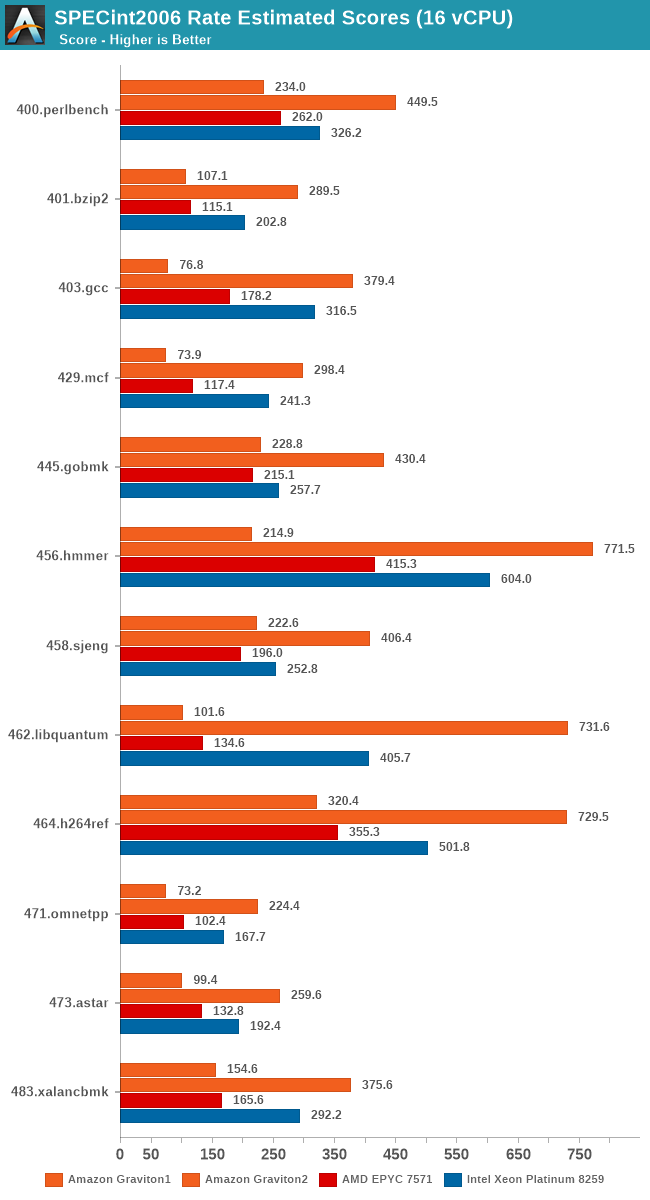
The comparison between the two generations of Graviton processors here is also astounding. Memory intensive workloads favour the newer Graviton2 by at least a factor of 2x, more often 3x, 4x, 5x and even up to 7x in libquantum.
The AMD system as expected doesn’t gain much scaling from using less cores as there’s no more shared resources available on a per-thread basis. The Intel chip fares slightly better per-thread, but doesn’t see the same higher performance scaling (Or should I say, reverse-scaling) as achieved by the Graviton2.
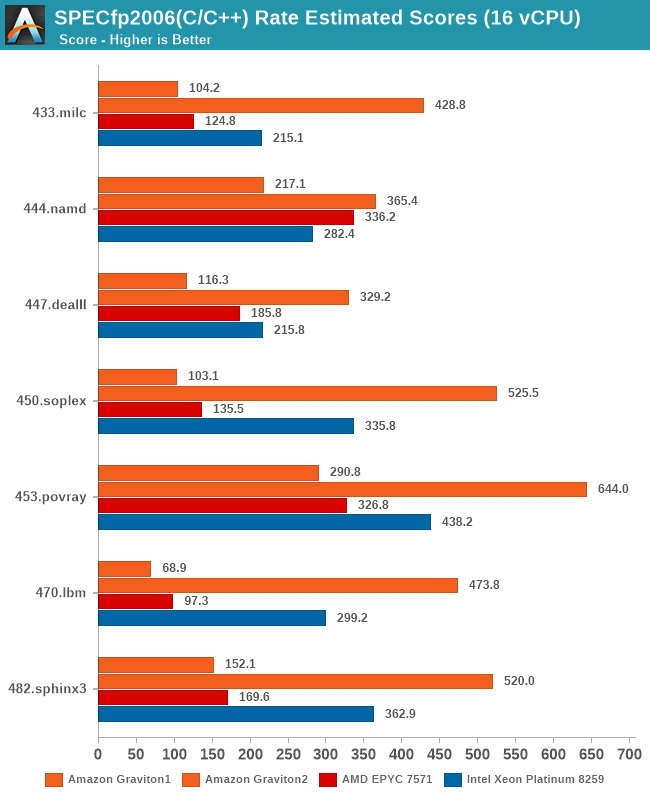
In fp2006, we see more or less the same kind of results.

Overall, in the 16-vCPU rate results the Graviton2 surpasses the performance advantage it showcased in the 64-core results, ending up with an even bigger margin.
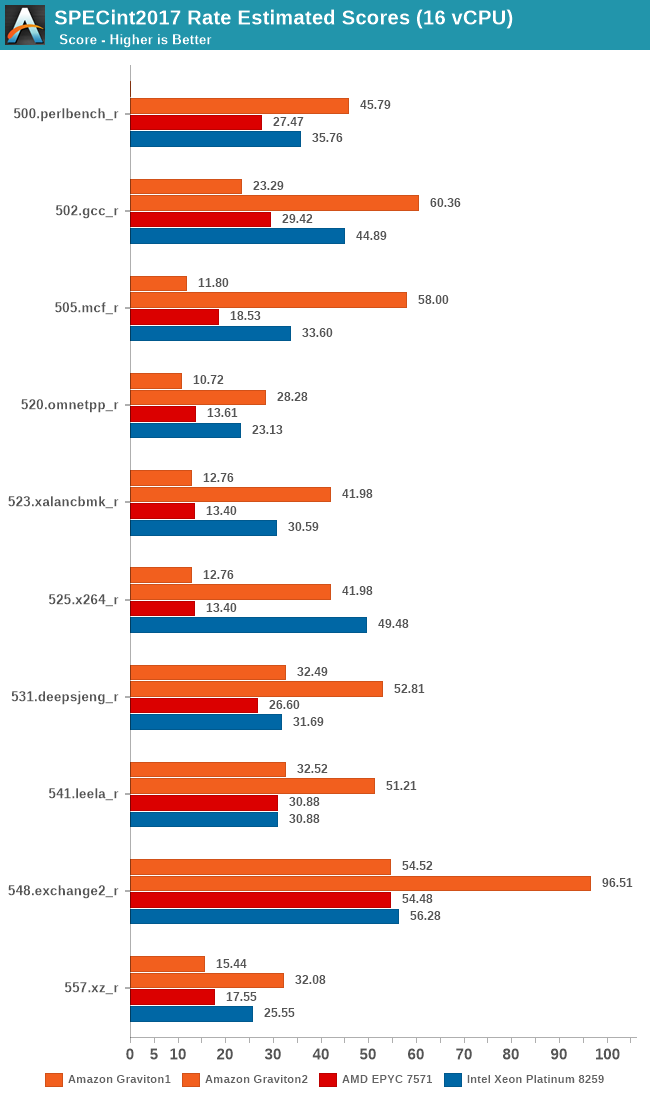
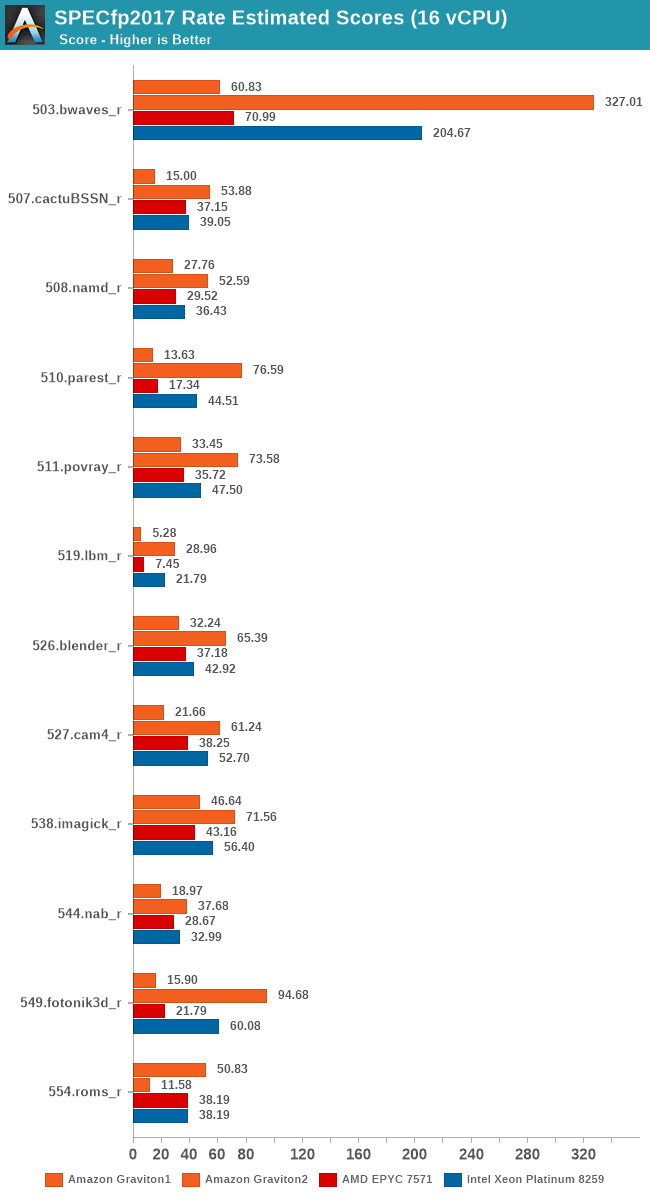
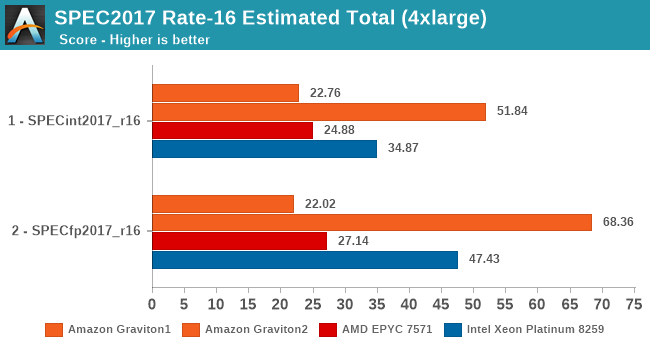
The SPEC2017 results again show the same conclusion – the Graviton2 really gains a ton of per-thread performance through the ability to use more of the chip’s L3 cache and 8 memory channels. Whilst on the 64-rate results the Graviton2 and the Xeon were neck-in-neck in fp2017, here the Graviton ends up with a 44% performance advantage.
Again, I can’t put enough emphasis on this, but these results are a best-case scenario for the 4xlarge 16vCPU results of the Graviton2. If production instances are able to achieve such figures will very largely depend on the draw of luck on whether you’re going to be alone on the physical hardware or whether you’ll have any neighbours on the chip. And even if you have neighbours, the performance figures will largely depend on what kind of workloads they will be running alongside your use-cases.
I saw a few articles out there comparing the performance between the m6g instances against the m5 generation instances (Skylake-SP hardware), but most of these tests were done only on medium (1 vCPU) to xlarge (4 vCPUs). When reading such pieces, it’s naturally important to keep in mind the vast scaling advantage the Graviton2 chip has – the smaller your instance is the more chance you’ll have noisy neighbours on the hardware, something that currently just doesn’t happen in the Graviton2’s preview phase.










96 Comments
View All Comments
SarahKerrigan - Tuesday, March 10, 2020 - link
That single-thread performance is extremely impressive. The multithreaded scaling is ugly, though. Back when N1 was announced, ARM seemed to think 1MB/core was a good spot for Neoverse LLC - I wonder why both Graviton and Altra are going for considerably less.shing3232 - Tuesday, March 10, 2020 - link
it's gonna costly(die and power wise) to build a interconnect for 64C with good performance. by the time, it would lost its power/perf edge I suppose.Tabalan - Tuesday, March 10, 2020 - link
Scaling might not be optimal, but performance loses are to expected if you greatly reduce available cache. In the end, MT performance is still far ahead of competition.ballsystemlord - Thursday, March 12, 2020 - link
You have to remember that the competition is not 64 cores, but 64v cpus. The difference is 60% or more. The Arm Graviton2 is being placed into the best possible light by this comparision.ballsystemlord - Thursday, March 12, 2020 - link
I mean 60% for the cores that are actually 1 thread. As in, the performance boost by turning on SMT is 40% best case scenario.autarchprinceps - Sunday, October 25, 2020 - link
I have to disagree. You seem to forget that the arm chip is cheaper. It’s an additional win if it manages to integrate more cores and yet still achieve a comparable single threaded performance. It’s not unfair to compare two products with one seeming to have a stat advantage from the start, if it’s still cheaper or costs the same. Why should a customer care?zamroni - Thursday, March 12, 2020 - link
L caches uses sram which needs 6 transistors per bit.So, every 1MB needs all least 48 millions transistors without counting transistors for the controller
dianajmclean6 - Monday, March 23, 2020 - link
Six months ago I lost my job and after that I was fortunate enough to stumble upon a great website which literally saved me• I started working for them online and in a short time after I've started averaging 15k a month••• icash68.coMRallJ - Tuesday, March 10, 2020 - link
Comparisons made are to the whole core performance of Graviton to just thread performance of Xeon/EPYC. It's very problematic.Also TDP rating for the graviton is off by 50% based on what was reported at re:Invent.
Andrei Frumusanu - Tuesday, March 10, 2020 - link
I go over the core/SMT topic in the article, it's only a problem from a hardware comparison aspect, but it's very much the correct comparison from a cloud product offering comparison. The value proposition also does not change depending on core count, the instances are priced at similar tiers.